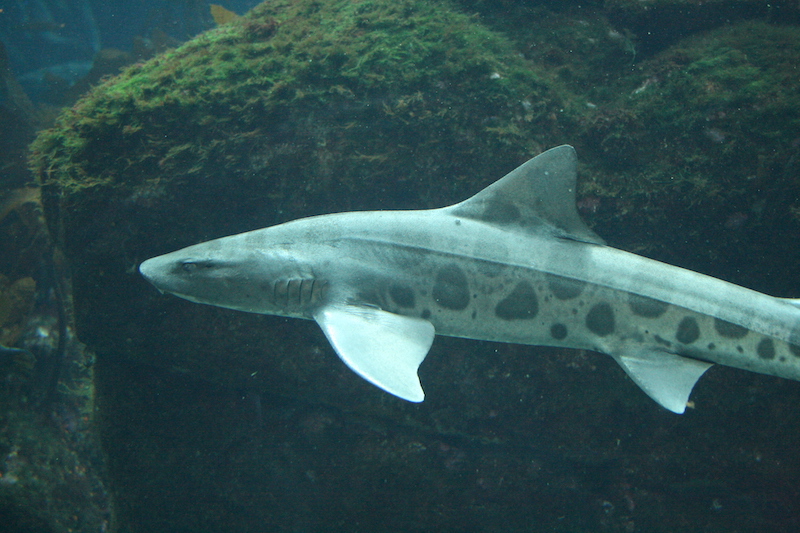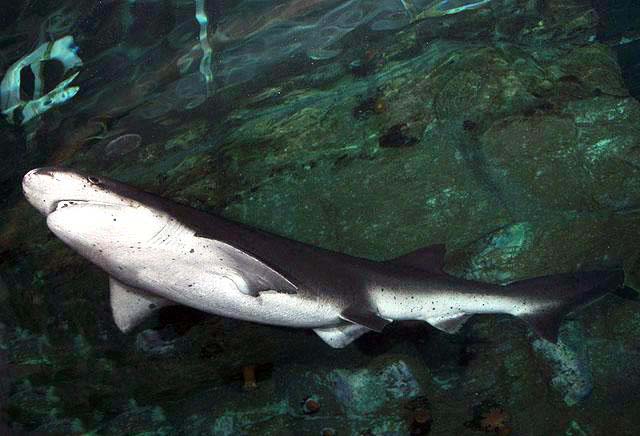Malibu is one of the most well-known celebrity beach towns in the world.
Many of Hollywood’s A-listers and the world’s elite call Malibu home in some form, and it’s easy to see why! With rolling hills, sunny beaches, and endless views of the Pacific Ocean, it’s no surprise that Malibu is a sought after destination.
But it’s not just great for living — it’s a fantastic vacation town as well.
Malibu has many options for beachtime recreation, and it’s perhaps best known for it’s surf culture and locations. It also offers over 20 miles of coastline — most of which is beaches — that are open for surfing as well as swimming, snorkeling, fishing, and scuba diving.
If you’re heading to the beach at Malibu, one big question to keep in mind is:
Does Malibu have sharks?

Malibu, California’s Pacific beaches can attract sharks, however they’re not very likely to enter shallow water. Only a small handful of shark attacks have ever been recorded in Malibu.
The most common types of sharks you might see offshore in Malibu are:
- Great Whites
- Hammerheads
- Leopard sharks
- And sevengill sharks
Let’s take a look at each of these sharks, photos, shark attack history in Malibu, and some shark safety tips!
Types of Sharks Near Malibu, CA
Sharks are quite common near Malibu’s top beaches (El Matador State Beach, Malibu Lagoon State Beach, Westward Beach, etc.) and along the CA coast.
They are identifiable when they come to the water surface; however, it’s easy to mix them up with dolphins, as they have very similar dorsal fins.
In fact, most “shark sightings” turn out to be harmless and friendly dolphins!
If you do spot a fin, you can distinguish a dolphin from a shark by the way it swims: dolphins have an up-and-down motion, while sharks move to side to side.
Fortunately, most of the sharks near to the shore in Malibu don’t pose a threat to humans. There are more dangerous species in the Pacific, like the Great White shark, but they most often stay in deeper waters much farther from shore, where there is more food.
While you’re unlikely to encounter any on your trip to Malibu, here are a few of the shark species that call this coastal California water their home.
Great White Shark

We’ll start with the most dangerous. The great white shark is one of the world’s apex predators, and it is well-known that they are quite numerous along the California coast — but again, generally farther from shore where they don’t pose a threat.
The most common instances of great whites here is in juvenile sharks, not adults, as they’re the most likely to venture closer to shore.
Great white sharks are one of the most aggressive species of sharks, which is part of why they are labelled as a predator by humans — even though we are not typically their prey, great whites have been known to still bite and attack humans.
In fact, great whites are responsible for an overwhelming proportion of all shark bites.
Great white sharks can be quite large.
The biggest are adult females, averaging between 15 and 16 feet long and weighing anywhere between 1,500 lbs and 2,500 lbs, though the largest recorded was over 20 feet long.
Again, though, you’re very unlikely to run into a great white on the beaches of Malibu — they prefer much deeper water.
Hammerhead Shark

The smooth hammerhead shark falls on a similar end of the spectrum for Malibu sharks.
They are generally not believed to be responsible for notable shark attacks, but they are capable of it.
That being said, as far as their interaction with humans, they are best known for stealing fishing catches.
It’s important to note that while some species of hammerhead shark are docile and safe to swim with, like scalloped hammerheads, the smooth hammerhead found in California is not.
While they are considered a predator, smooth hammerheads similarly tend to avoid waters close to shore — the chances of a swimmer encountering a smooth hammerhead near Malibu are basically zero.
This species is, of course, a type of hammerhead shark, and has the same wide, flattened head as others of the type, making it very easily recognizable.
Smooth hammerheads are similar in size as the great whites, averaging around 16 feet long.
Leopard Shark

Leopard sharks are found along most of the west coast, with their range extending from Baja California in the south to Oregon in the north.
They’re the most common type of shark in California, spending time between shallower waters during high tide, and deeper waters as the tide recedes.
They’re usually found near the bottom, along the sea floor.
Leopard sharks are considered harmless towards humans. In fact, they’re known for being quite docile, and it is safe to swim with them or snorkel nearby.
They are also some of the most beautiful sharks, thanks to their coloring, and swimming with them can make for a very memorable experience.
Leopard sharks are aptly named for their unique brown and black coloring, with dark spots along its body and saddle marks along its dorsal side, resembling a leopard.
Leopard sharks are much smaller (and friendlier) than their predator counterparts.
On average, these Malibu sharks come in between 4 and 5 feet long, and never weigh more than 40 lbs. In fact, they’re so small that they’re actually prey to other larger sharks, like great whites sharks and sevengill sharks.
Sevengill Sharks

Sevengill sharks are the shark that most people picture when they think of California sharks.
This is largely due to how well this species can adapt to captivity, meaning that these sharks are commonly found in aquariums.
They are gray, with a broad nose, and can grow to a little over 9 feet in length. It’s also been known as the cow shark and the mud shark.
It’s the only Californian shark to have seven gill sets.
Sevengill sharks can be aggressive when provoked. They are considered dangerous, but mostly as a matter of their proximity to human activity relative to other large shark species, especially in the group of Malibu sharks.
Still, you’re not likely at all to run into a Sevengill shark in Malibu, and even less likely to suffer an attack.
(Before you read on, learn about jellyfish in Malibu.)
History of Shark Attacks in Malibu
Shark attacks in the U.S. around the globe are significantly less likely than mainstream media coverage would have us believe.
The common reference point, while heavily used, is very true: you’re more likely to be struck by lightning while standing on a beach than attacked by a shark.
Similar outlets and news coverage would also paint sharks as a predator to humans. Again, false.
Sharks are predators — some of the highest up in marine ecosystems — but they do not prey on humans.
Most cases of shark bites in any region are a result of a human being mistaken for something else. Even in the event that a shark does bite a human, it most often simply lets go when it realizes that the person it’s bitten isn’t the seal or other prey that it was looking for.
While over-represented, there are cases of dangerous and deadly shark attacks.
In California, shark attacks have been recorded since the early 20th century, and only seven of those were in Malibu — and there’s only ever been one fatal shark attack here since recording began a hundred years ago.
In reality, sharks are in far more danger from us, than we are from them. In many places across the globe, sharks have been hunted to near extinction.
Avoiding Shark Attacks while in Malibu (Tips & Things to Know)
Avoiding a shark attack is straightforward as long as you take the necessary precautions.
Most days on a California beach like those in Malibu pass uneventfully, with families and surfers enjoying the water.
If, however, there has been shark activity reported in recent days, there are some extra precautions you can take to be the most mindful of your environment.
Here are 5 tips to avoid shark attacks and take good caution while swimming in ocean waters.
- Don’t swim at dawn or dusk. It’s best to avoid swimming at times when sharks are most active, which is at night, or dawn and dusk. Sharks are rarely active during the day.
- Be mindful of physical activity. Avoid doing things that could attrack the attention of predators, like excessive splashing. This behavior can closely resemble the erratic movements of prey, like a splashing seal, for example.
- Avoid shiny jewelry. Similarly, shiny objects like jewelry or embellished swim suits can also attrack predators by mimicking the appearance of fish scales. While fish taste better than humans, if mistaken, a shark could still bite.
- Always swim with a partner or in a group. This is a fairly simple additional precaution. If there is a shark nearby that’s looking to nibble, it is less likely to approach a group of people than it is to approach a lone swimmer (though that is also unlikely, as a general statement).
- Don’t go far from shore. There are several reasons for this. First, the farther you are from shore, the more like you are to also be far from groups of people. Second, sharks rarely swim in shallow water. If they are swimming nearby a beach, they’re most likely to be in slightly deeper water just offshore, so straying in that direction increases the risk of encounter. And third, in the unlikely event of a bite, the farther you are from shore, the farther you are from help.
Lastly, always follow the guidelines from officials.
Lifeguards will have up-to-date information on known shark activity in the area, and will be able to provide sound knowledge on both safe behavior and potential risks given the conditions.
In the event of a shark sighting, follow directions from officials on exiting the water, and don’t return to it until they give the all-clear.
Wrapping Up
A trip to Malibu doesn’t need to overshadowed by a fear of sharks.
Beaches here are well patrolled, and even host some of the world’s most iconic surfing culture, meaning enjoying the beaches and going for a swim are well within reach for a Malibu vacation.
Malibu sharks can make appearances, but as long as you’re equipped with smart tips to reduce the chance of a careless encounter, and stay mindful of instructions from lifeguards and other officials, your trip to this beautiful Southern California surf town is sure to be memorable.
For more shark guides, check out:
Hope this helps!